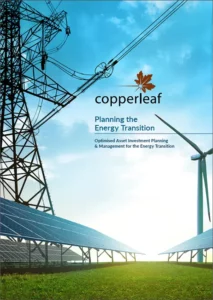Optimised Asset Investment Planning & Management for the Energy Transition
Europe aims to be the first climate-neutral continent, committing to reach this goal by 2050. To meet the challenge of a net-zero emissions future, the European Union is accelerating the energy transition and changing the way energy is generated, managed, distributed, regulated, and used. How can organisations transform their asset investment planning and management (AIPM) processes to help navigate and adapt to the rapidly changing energy sector?
Traditional asset management tools and investment processes use past learning to prioritise future work. This approach works for large traditional grids. However, today’s modern electricity grids require advanced AIPM processes, such as the British CNAIM, that rely on a combination of per-asset consequences and failure probabilities, and provide the granularity and specificity needed to tackle grid volatility and asset diversity. These processes allow for improved decision making at the portfolio level and provide a better reflection of the local needs and criticalities of the assets involved. They also enable organisations to incorporate changing service level targets and resource availability into their decision making to create plans that are both adaptable and deliverable.
Legacy asset management tools are not equipped for emerging technologies. As the workforce ages and senior people retire, this expertise is lost, making it challenging to transfer the knowledge and experience gained from successful pilots and projects into a long-term plan.
Successful grid operators need to enhance their planning capabilities by combining a value-based bottom-up approach to asset management and risk analysis with a top-down approach to portfolio optimisation. This will enable grid operators to address current maintenance needs, while planning to meet future net-zero, energy transition, and Environmental, Social and Governance (ESG) targets. Company-wide targets on CAPEX, OPEX, and key service metrics can be met while mandated work, such as connecting new distributed energy resources like wind turbines and farms, can be carried out.
A successful approach allows innovation projects and novel solutions, such as smart-grid intelligence and battery storage, to become potential investment options that can be compared on equal footing with existing investments across an organisation’s entire investment portfolio.
At Copperleaf®, we believe that a value-based decision-making approach aligned with the ISO 55000 asset management standard is key to establishing a common basis to leverage the opportunities and solve the challenges of the energy transition. The Copperleaf Decision Analytics Solution creates transparency across all risks and projects so that organisations can quickly understand the areas in which new technologies can provide value. It provides a common economic scale on which to evaluate new ideas, competing technologies, and different approaches to solving the same challenges.
A value framework underpins this approach, allowing strategic objectives, risk assessments, and actionable alternatives to evolve over time, as external circumstances change (new strategic or regulatory requirements) or the intrinsic merit of a technology improves. This allows organisations to combine all objectives and needs across the entire enterprise into an optimal investment plan that considers all resource, funding, and timing constraints.
Copperleaf has an important role to play in helping organisations plan the energy transition. We have been working at the forefront of asset management best practices for more than 20 years, delivering best-in-class decision analytics solutions to many of the world’s largest and most respected utilities.
Download this white paper to learn about 4 best practices to help plan the energy transition.


